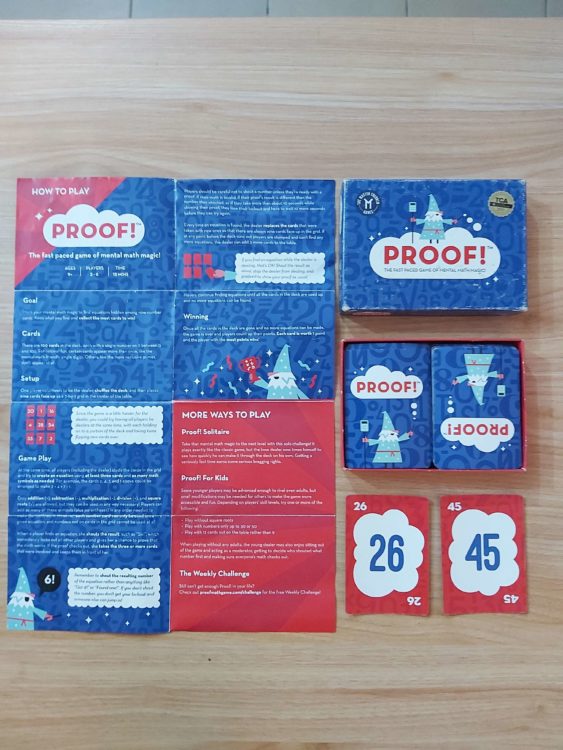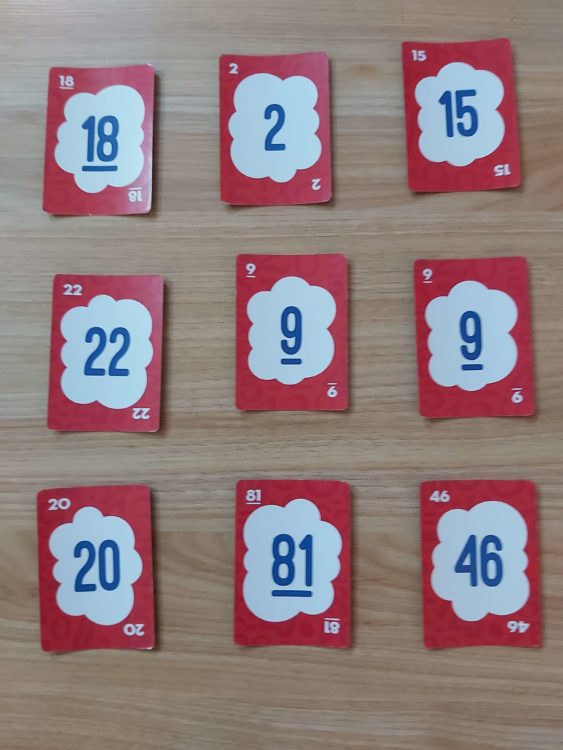
OBJECTIVE OF PROOF: Find as many hidden equations as you can from a grid of nine cards. Collect as many cards as you can and win the game.
NUMBER OF PLAYERS: 2 to 6 Players
COMPONENTS: A deck of 100 cards and a rule sheet.
TYPE OF GAME: Drafting Math Card Game
AUDIENCE: Ages 9 and Up
OVERVIEW OF PROOF
Get your mental juices flowing as you try to find as many equations as possible from the cards faced up on the table using the four basic math symbols and square roots. Shout out your answer, be quick to prove it and earn your cards.
SETUP

Choose a dealer to shuffle the deck of cards and then place nine of the cards face up on the table or play area in a 3 by 3 grid
GAMEPLAY
Everyone plays at the same time.
Once the cards are arranged on the play area, all the players study the cards in play hoping to discover an equation amongst them. If a player succeeds in discovering one, the player shouts out the answer, not the equation or ‘found it’
Once this is done, all other players are locked out of the game for a few seconds which means they have to pause and listen to the active player (the person who shouted out their answer) prove their answer.
The active player is then expected to call out the cards that show the equation whose result they called out.
For example from the grid of numbers shown above, player ‘A’ may call out 81 and has to proof that 9 multiplied by 9 equals 81 or call out 18 and prove that 9 plus 9 is 18. Player ‘B’ may have noticed that 20 plus 2 equals 22 so shouts out 22 while player ‘C’ noticed that 18 plus 2 equals 20 so they call out 20.

The first to call out their answer would be the player to prove it first.
The players must utilize at least three cards for every equation and can use any of the five symbols earlier mentioned as many times as needed. A number card can only be used once in each equation and equations must be restricted to the cards shown in the grid.
If the cards called out prove the equation correctly, the player gets to keep the cards and new cards from the deck are used to replace them in the grid. At all times, there must always be 9 cards in the grid.
As plays winds down and the players find it difficult or impossible to find any equation from the number cards in the grid, the dealer may add three more cards to up the number of cards in the grid to 12.
Play continues until the deck of cards is used up and no more equations can be formed from the cards in play.
A Variant for Younger Kids
To accommodate younger kids and encourage their interest in the game, slight modifications may be made to the rules.
- The grid can be increased to 12 cards to make more options available
- The symbol for square roots can be excluded
- Reduce the total of the equation to 30 0r 50
SCORING
At the end of the game, all players count their cards. Every card represents one point. The player with the highest cards and thus points wins.
END OF GAME
The game ends once the deck runs out and no more equations can be derived from the cards on the table.